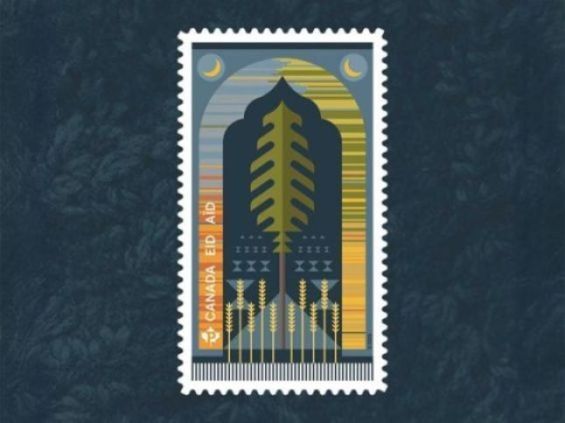To mark Eid al-Fitr, the celebration that ends Ramadan, families and friends in Canada can exchange greeting cards and gifts using a specially designed stamp symbolizing sharing and strong family bonds. Canada Post has issued 300,000 copies of this new stamp, which blends Muslim and Indigenous cultures, drawing inspiration from the Canadian Prayer Rug.
The stamp aims to highlight the deep connections between the Muslim community and Canada through a design that incorporates shared cultural symbols. The Canadian Prayer Rug was originally created in 2016 as part of a project by The Green Room, a youth program run by the Edmonton-based charity IslamicFamily, which provides spiritual and cultural services to the local community, according to Canada Post’s magazine.
Omar Yaqub, executive director of IslamicFamily, told Radio-Canada that the rug represents a sense of belonging through reconciliation, learning about Indigenous histories, and building connections with neighbors. It also reflects the historical use of floral motifs in Islamic art, which appear in architecture, textiles, and prayer rugs.
«In this spirit, in 2016, a group of young Muslims met with Indigenous elders and descendants of the first settlers to explore what a uniquely Canadian prayer rug might look like», the magazine explains.
 Canadian Prayer Rug
Canadian Prayer Rug
A Collaboration Between Métis and Muslim Artists
These conversations led to a collaboration between Métis designer Kit Craven and weaver Noor Iqbal, who created a hand-woven wool rug. The design reflects Alberta’s diverse landscapes and incorporates symbols from both Indigenous and Muslim traditions.
The rug features a dome and a twisted pine, a nod to Lebanon’s cedar tree—a homeland for many Muslims in Canada. Blue triangles represent Cree culture, symbolizing the Alberta Rockies and the North Saskatchewan River, while wheat stalks signify abundance. The crescent moons reference the lunar calendar, which plays a significant role in both cultures and marks the start of Ramadan.
According to Canada Post, this creation embodies the rich cultural ties woven over time, as Canada’s Muslim community has been present for over 80 years.
A Legacy of Muslim Presence in Canada
The Muslim community in Canada contributed to building the country’s first mosque in 1938 in Edmonton. The project was spearheaded by Lebanese-Canadian Hilwie Hamdon (1905–1988), who rallied Edmonton’s Muslim community and led efforts to establish Al-Rashid Mosque, according to The Canadian Encyclopedia, cited by Présence Info.
 Canada Post
Canada Post
At the time, Canada’s Muslim population was about 2,000, with just 40 families in Edmonton. Reports from La Patrie in 1938 describe the mosque as featuring a single-floor structure, a central dome, two minarets, a paved courtyard, and a basement.
This history deeply influenced the artistic choices for the new stamp. Canada Post describes the design as «more than a work of art», emphasizing that «this rug symbolizes unity and multiculturalism on Treaty No. 6 territory, which includes Edmonton».
This Eid stamp is part of a broader effort by Canada Post to celebrate cultural diversity. The institution has previously issued six other special stamps for Muslim holidays and also produces stamps for Diwali, Hanukkah, and Christmas, reflecting Canada’s multicultural fabric.





 chargement...
chargement...













